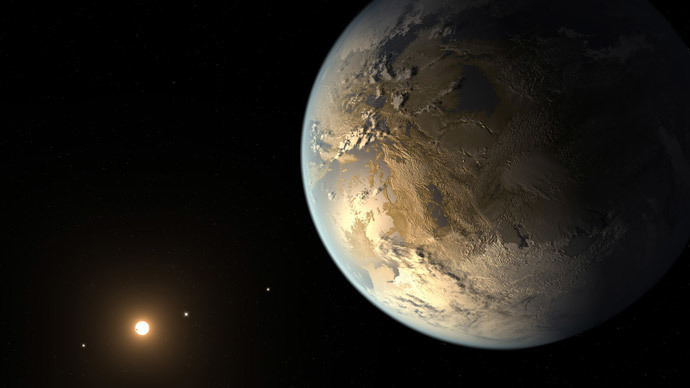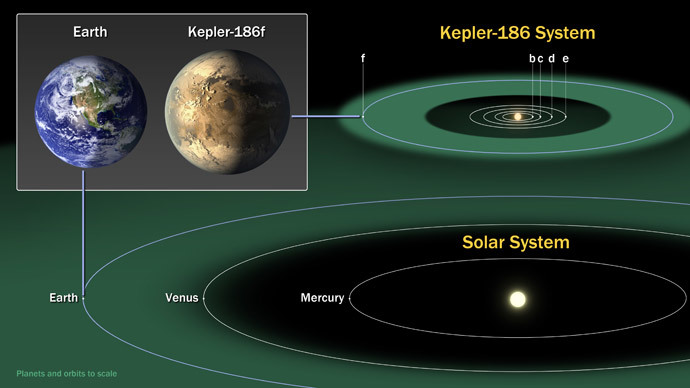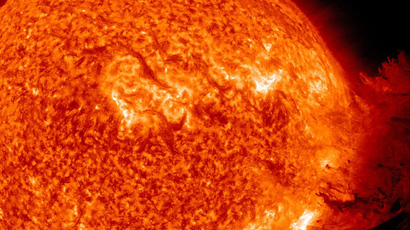NASA discovers most Earth-like planet in 'Habitable Zone'

NASA’s Kepler Space Telescope has found an Earth-sized planet within the habitable zone of the star it orbits, the space agency announced Thursday.
The planet, which NASA calls Kepler-186f, is located in the constellation Cygnus, about 500 light-years from Earth. Kepler-186f orbits the star Kepler-186 once every 130 days and receives one-third of the energy from that star than Earth does from the sun, NASA said in a statement. The amount of energy Kepler-186f receives at noon is similar to what Earth receives an hour before sunset, which places the newly discovered planet at the outer edge of the habitable zone.
NASA defines the habitable zone as “the range of distance from a star where liquid water might pool on the surface of an orbiting planet.” Being in the habitable zone, however, does not guarantee that life is possible, just that it could be.
"We know of just one planet where life exists -- Earth. When we search for life outside our solar system we focus on finding planets with characteristics that mimic that of Earth," Elisa Quintana, research scientist at the SETI Institute at NASA's Ames Research Center in Moffett Field, Calif., and lead author of the paper published in the journal Science, said in the NASA statement. "Finding a habitable zone planet comparable to Earth in size is a major step forward."
Kepler-186 is located near the bright star Deneb, which is one of the defining stars of the Cygnus constellation, according to the French blog Around the Sky. It is classified as an M dwarf (also known as a red dwarf) star, which means it is smaller and dimmer than the sun, NASA said. This particular star is about half the size and mass of Earth’s sun. M dwarfs make up approximately 70 percent of the stars in the Milky Way.

"The host star, Kepler 186, is an M1-type dwarf star which means it will burn hydrogen forever, so there is ample opportunity to develop life around this particular star and because it has just the right orbital period water may exist in a liquid phase on this planet," said Notre Dame astrophysicist Justin R. Crepp in Science Codex.
There is much that is unknown about the Kepler-186f planet, including its mass and composition, though the researches posit that the planet is likely to be rocky. NASA does know that the planet is less than ten percent larger than Earth.
“The Kepler space telescope infers the existence of a planet by the amount of starlight blocked when it passes in front of its star. From these data, a planet's radius, orbital period and the amount of energy [received] from the host star can be determined,” NASA said.
"Being in the habitable zone does not mean we know this planet is habitable. The temperature on the planet is strongly dependent on what kind of atmosphere the planet has," Thomas Barclay, research scientist at the Bay Area Environmental Research Institute at Ames and co-author of the paper, said in the NASA press release. "Kepler-186f can be thought of as an Earth-cousin rather than an Earth-twin. It has many properties that resemble Earth."
The Kepler telescope launched in 2009 with the goal of searching about 150,000 target stars for planets transiting (passing by) the telescope at least three times over the course of up to three years, Reuters reports. Researchers pore through archived data from Kepler to find planets that could be in the habitable zone, which is nicknamed the “Goldilocks Zone.”
"It's very challenging to find Earth analogs," Barclay said to Reuters. "Most candidates don't pan out, but things change as we get more measurements."
NASA says the next step is to look for true Earth-twins and to measure their chemical compositions. Kepler-186f will also be a target for future telescopes in the hopes of measuring its chemical composition, Reuters reports.














